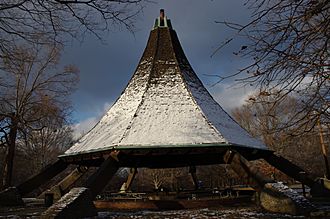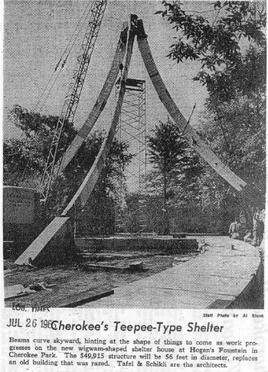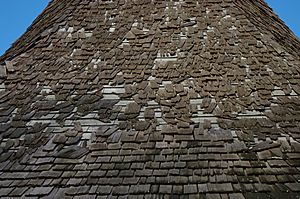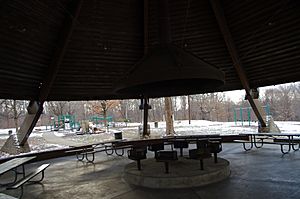Hogan's Fountain Pavilion facts for kids
Quick facts for kids Hogan's Fountain Pavilion |
|
|---|---|

Snow-covered pavilion. Taken December 2010
|
|
| Alternative names | Teepee, Witch's Hat |
| General information | |
| Architectural style | Mid-Century Modern |
| Location | in Cherokee Park |
| Address | 3110 Scenic Loop, Louisville, Kentucky, 40205 |
| Country | U.S. |
| Coordinates | 38°14′20″N 85°41′48″W / 38.23889°N 85.69667°W |
| Construction started | 1965 |
| Inaugurated | October 1965 |
| Cost | $49,915 |
| Owner | Metro Louisville Government |
| Landlord | Metro Parks |
| Height | 56 feet (17 m) |
| Technical details | |
| Floor area | 96 feet wide |
| Design and construction | |
| Architect | E.J. Schickli, Jr. |
| Architecture firm | Tafel-Schickli Architects |
| Main contractor | C.G. Campbell & Son, Inc. |
| Awards and prizes | Louisville's Best Local Landmark in 2011 and 2012 |
| Designations | 2011–2012 Most Endangered Historic Places in Kentucky, 2012 A Historic Landmark |
| Other information | |
| Seating capacity | 200 |
| Parking | Adjacent |
The Hogan's Fountain Pavilion is a large gazebo and picnic shelter. It has a unique mid-century modern style. You can find it in Cherokee Park in Louisville, Kentucky. It was built in 1965.
This pavilion is a popular spot for many events. You can rent it for parties or gatherings. When it's not rented, anyone visiting the park can use it for free. It's a favorite place for people in the community.
Louisville is known as the "City of Parks." It also has many unusual buildings. So, it makes sense that this "weird" or "offbeat" pavilion is in one of its most popular parks. People often call it the "Teepee" or "Witch's Hat." Its unique look fits right in with Louisville's motto: "Keeping Louisville Weird."
In 1974, a very strong tornado hit Cherokee Park. It destroyed over 2,000 large trees. But the pavilion survived with only minor damage! Later, in 1994, park officials planned to remove the pavilion. They wanted to make the park look like its original 1892 design. This design was created by Frederick Law Olmsted.
However, in 2010, a group of people decided to save the pavilion. They worked hard to stop it from being torn down. Because of their efforts, the Parks Department agreed to wait. This gave the group time to raise money for repairs.
Contents
About the Pavilion
The Hogan's Fountain Pavilion sits on top of Bonnycastle Hill. It's a key landmark along the 2.4-mile Scenic Loop in Cherokee Park.
How it was Built
The city's Parks and Recreation Department ordered the pavilion in 1964. It was first called the Hogan's Fountain Pavilion and Comfort Station. Later, its name was shortened. Many companies offered to build it. The city chose C.G. Campbell & Son, Inc. They agreed to build it for $49,915. The pavilion was ready for use in October 1965. Mayor William Cowger officially opened it.
The pavilion was also briefly named the McCall Shelter. This was to honor Alderman C.W. "Ches" McCall, who passed away in 1962. But most people still called it the "Teepee."
Its Architect
The Hogan's Fountain Pavilion was designed by Edward Jacob (E.J.) Schickli, Jr. He worked for Tafel–Schickli Architects. Mr. Schickli thought a cone-shaped "wigwam" or "teepee" design was perfect. It matched the park's name, Cherokee Park, which comes from Native American history.
Mr. Schickli was born in January 1928. He graduated from MIT in 1950. He became a registered architect in 1954. He achieved many important things before he was 37 years old. He designed the Hogan's Fountain Pavilion in 1964.
He also designed the original Louisville Zoo in 1969. He worked on the expansion of Louisville's Standiford Field Airport in 1970. This airport is now called the Louisville International Airport.
Mr. Schickli visited the pavilion in 2010. He hadn't seen it in 15 years. He was sad to see its roof falling apart. He said, "Money is often given to build them but never to take care of them." He hoped the pavilion would stay for a long time. He believed it still had "a lot of life left in it." He also said, "It's a whimsical structure; the type of thing I believe belongs in parks."
Unique Design
The pavilion's shape caught a lot of attention. It was very different from the usual rectangular shelters. A photographer from the Louisville Times newspaper took pictures of its early construction. The newspaper said, "Beams curve skyward, hinting at the shape of things to come…"
The pavilion has an unusual, eight-sided roof that reaches high into the sky. It was meant to look rustic with a wood shingle roof. But later, cement shingles were used instead.
The floor is a round concrete pad. It used to have a large fire pit in the middle. A big 13-foot wide smokestack was above the fire pit for venting smoke. The sides of the building were left open. This helps cool the pavilion by letting warm air rise and escape through the top. Copper was added to the exposed beams at the top of the roof to protect them from weather.
The large wooden beams are held in place by eight big concrete supports. These supports are covered with local stone. A brick building with restrooms is attached to one side.
The finished pavilion is 56 feet wide and 56 feet tall. The word "tipi" (another spelling of "teepee") means "to dwell" or "used for dwelling." This shows how Schickli wanted the design to connect with Native American ideas in the park setting.
Surviving the Super Outbreak Tornado
On April 3, 1974, Louisville was hit by a huge tornado outbreak. It was called "The Super Outbreak". It caused massive damage. Over 335 people died, and more than 6,000 were hurt.
In Cherokee Park, about 2,200 trees were destroyed. That's 75% of the park's big trees! But the Teepee pavilion stood strong. It only lost a few shingles. It was a true survivor in the storm.
Repairs and Upgrades
After the 1974 tornado, the pavilion's roof needed repairs. The Parks Department chose a company to fix it for $2,110. They used cedar shake shingles. To save money, they put the new wood shingles right over the old cement ones.
Later, in 1979, some of the pavilion's support beams were damaged. They were strengthened with steel for $12,000. More repairs were done in 1983. This included painting, fixing the smoke hood, and working on the stone supports. More beams were covered in steel for $16,000. In 1989, more steel was added to beams. A steel plate was also welded onto all eight beams. This was to stop children from climbing onto the roof.
Activities and Fun
The pavilion is surrounded by many fun things to do:
- A 2.4-mile paved road for walking, biking, and driving.
- A children's playground.
- A full basketball court.
- Trails for hiking and biking.
- Horseshoe pits.
- Parking for cars.
- Restrooms.
- A sprayground (a water play area).
- Swings.
- Volleyball courts.
- Water fountains.
Renting the Pavilion
The Hogan's Fountain Pavilion is the most popular spot in Cherokee Park for rentals. You can rent it for $150 per day. It's available all year. If it's not rented, anyone can use it for free.
The pavilion stays cool even on hot Kentucky summer days. This makes it a very busy place in warmer months. It earns over $18,000 a year from rentals. Many groups use it, like church groups, Scout troops, and families. It's also popular for weddings.
The pavilion can seat 200 people. It has eight grills and large picnic tables. These can fit eight families under one roof. More picnic tables are nearby. Parking, restrooms, and a playground are all close by.
Falling Apart
After 1994, the pavilion wasn't maintained very well. This lack of care caused a lot of damage, especially to the roof. The wood shingles hadn't been fixed since 1989. Because of this, the roof got very bad. Water started leaking in. The stone around the supports also came loose. From 2007 to 2010, the only repairs made were to two barbecue grills.
A group of people worried about the pavilion. They found a company that offered to repair the roof for $82,000. This was much less than another bid. This is when the group "Save Hogan's Fountain Pavilion" was officially formed. They started raising money.
In 2011, another company offered to fix the roof for $35,895. They even offered to donate some of their work. They suggested using asphalt shingles that looked like wood but would last longer.
After two years, the supporters raised enough money to fix the roof. But then, park officials found asbestos in the old shingles. Asbestos is a material that can be dangerous if disturbed. So, a special company had to be hired to remove the shingles safely. This added another $28,129 to the cost.
Saving the Pavilion
In March 2010, a Louisville resident named Lark Phillips started the "Save Hogan's Fountain Pavilion" group. They wanted to save this unique building from being torn down.
The group met with the Parks Department. They agreed to delay removing the pavilion if the group could raise money for repairs.
Devin Colman, from the Recent Past Preservation Network, supported saving the pavilion. He said tearing it down would be like "changing history." He pointed out that the Parks Department's plan went against rules for protecting historic places. These rules say that old buildings should be kept as they are, and changes that make them look "fake old" should not happen.
Raising Money
The "Save Hogan's Fountain Pavilion" group partnered with the Adam Matthews Foundation. This non-profit group helped them raise money. The foundation even matched some donations.
Their first fundraiser was a concert in August 2010. They also sold T-shirts, which were very popular. They even had a letter-writing campaign. One letter led to a $1,000 donation from YUM Brands.
Local pubs held a "Fund Day" where all profits went to the pavilion. This raised $2,500. A "Louisville Hippie's Reunion/Benefit" event also raised $1,700. The pavilion's architect, E.J. Schickli, Jr., spoke at this event. He said, "My body at almost 85 years of age, it's stood a long time, but I've had maintenance; and if I had so little maintenance as that structure I would have been gone long ago."
Mr. Schickli's sons also donated $5,000 and offered a matching grant. By August 2012, the group had raised over $45,000 to repair the roof.
Who Opposes and Supports It?
Some groups, like the Louisville Metro Parks Department and the Olmsted Parks Conservancy, opposed saving the pavilion. They believed it didn't fit the original park design. They said its size caused problems like soil damage and harm to nearby trees.
However, many others supported saving it. Tammy Madigan, a spokeswoman for the supporters, said, "It's important to preserve significant architecture that makes Louisville unique."
Many organizations supported the pavilion, including the Kentucky Heritage Council and the National Trust for Historic Preservation. Richard Guy Wilson, a famous architectural historian, even suggested it be named one of "America's 11 Most Endangered Historic Places." He said, "This vision of the American past as a sanitized place in which nothing ever changes is not very smart, especially when you have such an outstanding design as Hogan's Pavilion."
Steve Wiser, President of the Louisville Historical League, said, "The community supports saving this structure." Mark Dennen, from the Kentucky Heritage Council, called it "a fine example of modernist architecture and worthy of protection."
In 2011 and 2012, the Hogan's Fountain Pavilion was voted "Best Local Landmark" in the LEO Reader's Choice Awards. The "Save Hogan's Fountain Pavilion" group was also ranked highly.
Becoming a Landmark
To protect the pavilion, the group collected over 400 signatures. They submitted an application to the Historic Landmarks and Preservation Districts Commission.
In September 2012, a hearing was held. After four and a half hours of discussion, the Hogan's Fountain Pavilion was officially named a Local Landmark! This means it is now protected.
The Hogan's Fountain Pavilion is a special building to many people. It continues to capture the attention of architects, historians, and educators today.
Images for kids





